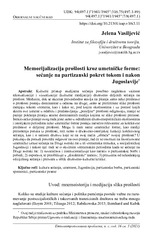Приказ основних података о документу
Memorijalizacija prošlosti kroz umetničke forme: sećanje na partizanski pokret tokom i nakon Jugoslavije
Memorialization of the Past through Artistic Forms: Rememberance of the Partisan Movement during and after Yugoslavia
| dc.creator | Vasiljević, Jelena | |
| dc.date.accessioned | 2021-11-22T11:49:54Z | |
| dc.date.available | 2021-11-22T11:49:54Z | |
| dc.date.issued | 2021 | |
| dc.identifier.issn | 2334-8801 | |
| dc.identifier.uri | http://rifdt.instifdt.bg.ac.rs/123456789/2458 | |
| dc.description.abstract | Kulturni pristup studijama sećanja posebno naglašava važnost tekstualizacije i vizualizacije (kulturne medijacije) društveno deljenih sećanja na prošlost. Međutim, dok se akcenat prevashodno stavlja na pitanja zašto neke predstave o prošlosti postaju dominantne u odnosu na druge, zašto se preferirane slike prošlosti menjaju tokom vremena, kao i kako se, pod kojim okolnostima i uz pomoć kojih aktera ove izmene u odabiru i predstavljanju „poželjne“ prošlosti odigravaju, manje se pažnje poklanja pitanju smene dominantnih medija kojima se slike prošlosti prenose. Istraživačko pitanje ovog rada jeste zašto u određenim društvenopolitičkim okolnostima i istorijskim periodima neke umetničke forme postaju naročito relevantne za kolektivne predstave o deljenoj prošlosti. Mogu li nam same umetničke forme, kao mediji prenošenja poruka iz prošlosti, reći nešto o društveno-istorijskoj funkciji kolektivnog sećanja, kao i o samom društvu koje se na ovaj način „obraća“ svojoj prošlosti? U pokušaju da ponudi potvrdni odgovor na ovo pitanje, rad će se osvrnuti na favorizovane umetničke izraze sećanja na Drugi svetski rat u tri vremenska trenutka, u socijalističkoj Jugoslaviji i nakon nje: radi se o okvirnim vremenskim periodima kada se sećanje na Drugi svetski rat: 1) ozvaničava i institucionalizuje kao narativ o partizanskoj borbi i pobedi; 2) osporava, te preoblikuje u „disidentski“ narativ; 3) preuzima od nekadašnjeg oficijelnog sećanja i pretvara u oblik društveno-kulturne kritike. | sr |
| dc.description.abstract | In memory studies, the importance of textualization and visualization (cultural mediation) of the socially shared memories of the past is particularly emphasized. However, while the accent is on the issues of the reasons for some representations to become dominant in relation to others, why the preferred images of the past change over time, as well as of the circumstances and actors that facilitate these changes in the choice and representation of the “desirable” past, less attention is paid to the change in the dominant media through which these images are transferred. This paper examines the reasons behind certain socio-political circumstances and historical periods that render particularly relevant some artistic forms in collective representations of the shared past. Can the artistic forms themselves, as the media of transfer of the messages from the past, testify of the socio-historical function of collective memory, as well as of the society that “addresses” its past in this manner? Aiming for the affirmative answer to this question, the text discusses the favoured artistic expressions of the memory of the World War II in three chronological segments in the socialist Yugoslavia and after its collapse, when the memory is 1) marked and institutionalized as the narrative of the partisans’ struggle and victory; 2) disputed and reshaped as the “dissident” narrative; and 3) taken over from the former official memory and transformed into a form of social-cultural critique. | sr |
| dc.language.iso | sr | sr |
| dc.publisher | Beograd: Odeljenje za etnologiju i antropologiju Filozofskog fakulteta u Beogradu | sr |
| dc.relation | info:eu-repo/grantAgreement/MESTD/inst-2020/200025/RS// | sr |
| dc.rights | openAccess | sr |
| dc.rights.uri | https://creativecommons.org/licenses/by/4.0/ | |
| dc.source | Etnoantropološki problemi | sr |
| dc.subject | kultura sećanja | sr |
| dc.subject | umetnost | sr |
| dc.subject | Jugoslavija | sr |
| dc.subject | partizanska borba | sr |
| dc.subject | partizanski spomenici | sr |
| dc.subject | partizanske pesme | sr |
| dc.title | Memorijalizacija prošlosti kroz umetničke forme: sećanje na partizanski pokret tokom i nakon Jugoslavije | sr |
| dc.title | Memorialization of the Past through Artistic Forms: Rememberance of the Partisan Movement during and after Yugoslavia | sr |
| dc.type | article | sr |
| dc.rights.license | BY-NC-ND | sr |
| dc.citation.issue | 3 | |
| dc.citation.volume | 16 | |
| dc.citation.spage | 899 | |
| dc.citation.epage | 915 | |
| dc.identifier.doi | 10.21301/eap.v16i3.11 | |
| dc.type.version | publishedVersion | sr |
| dc.identifier.fulltext | http://rifdt.instifdt.bg.ac.rs/bitstream/id/8694/bitstream_8694.pdf |

